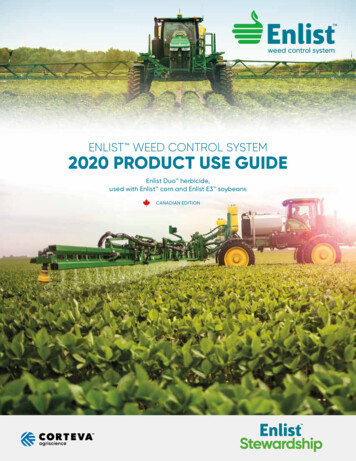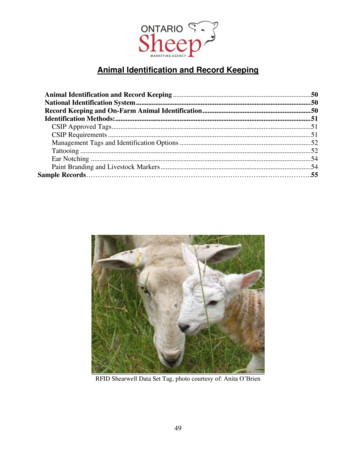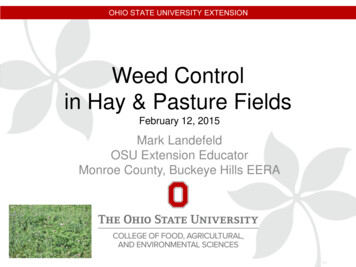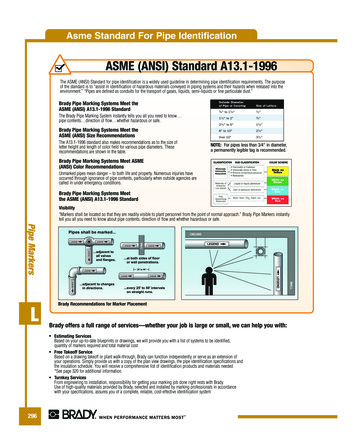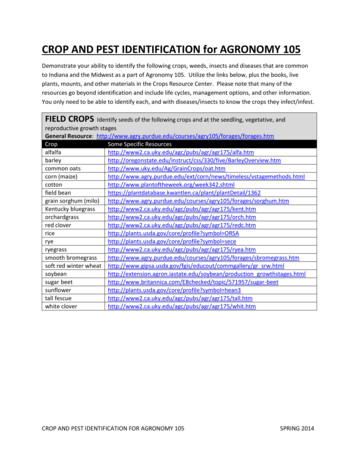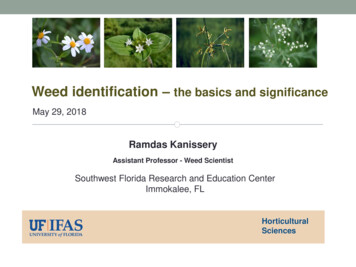
Transcription
Weed identification – the basics and significanceMay 29, 2018Ramdas KanisseryAssistant Professor - Weed ScientistSouthwest Florida Research and Education CenterImmokalee, FLHorticulturalSciences
Talk contentsIntroduction-Significance of weed idWeed identification - basics- Morphology- Life cycleWeed id resources & toolsPlant identification servicesSummary
Talk contentsIntroduction-Significance of weed idWeed identification - basics- Morphology- Life cycleWeed id resources & toolsPlant identification servicesSummary
“What are weeds?”
“What are weeds?”A plant growing where it is not wantedPurslane: weed in vegetable beds
“What are weeds?”A plant growing where it is not wantedPurslane: weed in vegetable bedsPurslane: Potted plant 10 - 15
“Weeds are plants that maintaintheir abundance under conditions ofrepeated disturbance”- Liebman
“Weeds are plants that maintaintheir abundance under conditions ofrepeated disturbance”- Liebman“A weed is a plant that has masteredevery survival skill except for learninghow to grow in rows” – Doug Larson
What are weeds doing in my farm or garden?Compete forlight, nutrients,moisture andspaceWeedy row-middle in sweet cornSWFREC Veg Farm
What are weeds doing in my farm or garden?Compete forlight, nutrients,moisture andspaceGiant Amaranth or Pig weedImmokalee, FL
What are weeds doing in my farm or garden?Interfere withharvestingGiant Foxtail in snap beansFigure credit: Mark Schonbeck, VirginiaAssociation for Biological Farming.
What are weeds doing in my farm or garden?Source of pestand diseases Alternate host for pests and diseasesFigure credit: Mark Schonbeck, Virginia Association forBiological Farming.
What are weeds doing in my farm or garden?Source of pestand diseases Alternate host for pests and diseasesWeeds growing adjacent to the croprow providing a moist and favorableenvironment for fungal growth on thetomato foliageFigure credit: Mark Schonbeck, Virginia Association forBiological Farming.
“Weeds can hurt your garden and theyhave to go”
“Four S of weed management”scoutingSelection of control timingSanitationSystematic weed identification
“Four S of weed management”scoutingSelection of control timingSanitationSystematic weed identification
Get the correct IdHeavy infestation of a weed speciesin a vegetable farm near Immokalee
Get the correct IdHeavy infestation of a weed speciesin a vegetable farm near Immokalee- Not responding to Glyphosate orParaquat- spend but no control
PartheniumGet the correct IdWeed was correctly identified asparthenium-Specific herbicide used
PartheniumGet the correct Id-Similarly looking weedsResponds differently toherbicidesRagweedSweet clover
Get the correct Id Dayflower- Looks like a dicot- Actually a monocot- So better response tograss killersDayflower growing in the dripline under the citrus tree
“Four S of weed management”scoutingSelection of control timingSanitationSystematic weed identification“Very important step for efficientand sustainable weed control”
Talk contentsIntroduction-Significance of weed idWeed identification - basics- Morphology- Life cycleWeed id resources & toolsPlant identification servicesSummary
Weed ID basics Morphology Structure and form Life cycle How it develops and reproduce
Weed ID basics Morphology Structure and form Life cycle How it develops and reproduce
Weed ID basics Morphology Identifying characteristicsLeaf - shape, arrangement, venation etc.
Weed ID basics Morphology Identifying characteristicsAlternateOppositeWhorledLeaf - arrangementwww.horton.ednet.ns.ca/staff/Richards
Weed ID basics Morphology Identifying formLeaf - shapeshttps://www.teacherspayteachers.com
Weed ID basics Morphology Identifying characteristicsStem - presence or absence of hairs
Weed ID basics Morphology Identifying characteristicsStem - presence of hairsFlorida Pusley – Richardia scabra
Weed ID basics Morphology Identifying characteristicsRoots – annuals vs perennials
Weed ID basics Morphology Identifying characteristicsFlower heads/seed heads - Shape, color etc.
MorphologyFlower/Seed headPurpleYellow v/s PurpleNutsedgeYellow
MorphologySeed headBahia grass‘V’ shaped seed head
MorphologySeed headBermudagrassSeed head cluster of 3-5
MorphologySeed headCrow footgrass‘Seed head looks like a crow's foot
MorphologyYellow v/s PurpleNutsedgeLeaf tipPurpleYellow
MorphologyYellow v/s PurpleNutsedgeLeaf tipPurpleYellow
MorphologyStem attachment to leafPennywort or Dollar weed:- stem attaches to the leaf in thecenter of the leaf
MorphologyStem attachment to leafPennywort or Dollar weed:- stem attaches to the leaf in thecenter of the leafDichondra:- stem attaches at the edge of akidney-shaped leaf
MorphologyStem attachment to leafPennywort or Dollar weed:- stem attaches to the leaf in thecenter of the leafDichondra:- stem attaches at the edge of akidney-shaped leafCreeping Charlie:- stem attaches at the edge of leaf- leaves have ragged edge
MorphologySheath ColorYellow foxtail:- Reddish leaf sheathNutsedge- green leaf sheathYellow nutsedge
MorphologyMonocots vs Dicots-A cotyledon is the part of the seed that will grow into the leaves.Dicots get their names fromMonocots has one cotyledonhaving two cotyledons instead ofone.http://jmgkids.us
Monocots vs Dicots-A cotyledon is the part of the seed that will grow into the leaves.Dicots get their names fromMonocots has one cotyledonhaving two cotyledons instead ofone.
Monocots vs DicotsMonocot leafs have parallel or up andDicot leafs have veins thatdown veinsare scatter or “netted.”- They do not follow a pattern.http://jmgkids.us
Dayflower- Actually a monocot- So better response tograss killersMonocot leafs have parallel or upand down veins
Monocots vs DicotsMonocot can be identified by their flowersparts. The flower parts on a monocot plantcome in multiples of 3Dicot flower parts come inmultiples of 4 or 5http://jmgkids.us
Monocots vs DicotsMonocotGrasses, sedgesDicotBroad-leafhttp://jmgkids.us
MonocotsMonocot“Grasses vs sedges”http://jmgkids.us
ceae/
Weed ID basics Morphology Structure and form Life cycle How it develops and reproduce
Life-cycle of weedsAnnualsComplete their life cyclefrom seed to seed inless than one year
Life-cycle of weedsAmaranthAnnualsCrab grassPusley
Life-cycle of pringSumer
Life-cycle of ll moistureGerminationv/sSummerAnnualsBoltingRosette growthWinter AnnualsSumer
Life-cycle of alsFall moistureGerminationv/sBoltingRosette growthWinter AnnualsSummerAnnualsSummer Annuals
Life-cycle of WinterAnnualsv/sSummerAnnualsCrab grass
Life-cycle of weeds- Emerge from seed & growduring the first yearBiennial- Produce flowers and produceseeds in the second year
Life-cycle of weedsBiennialCut leaf evening primrose– Rosette stage (First year)
Life-cycle of weedsRosette stageBiennialCut leaf evening primrose– Flowering stage (Second year)
Life cycle of weedsPerennials-Perennial weeds can grow andproduce flowers for multiple years-Produce vegetative structures thatgenerate new plants
Life cycle of weedsNut sedgePerennials Produce vegetativestructures Eg., stolons,rhizomes, tubers, orlarge rootsCreepingbeggar weed
Life cycle of weedsRhizome- undergroundPerennialsStolonStolon- above groundhttp://ipm.ucanr.edu
Weed ID basics Morphology Identifying characteristicsRoots – annuals vs perennials
Life cycle of weedsFibrous rootsAnnualsvsRhizome, StolonPerennialshttp://ipm.ucanr.edu
Talk contentsIntroduction-Significance of weed idWeed identification - basics- Morphology- Life cycleWeed id resourcesPlant identification servicesSummary
Weed Identification ToolsStumped in the Field?
Weed Identification ToolsWeb HelpPLANTS National Database (USDA)- Good information, some pictures- Searchable format- http://plants.usda.gov/
Weed Identification ToolsAtlas of Florida Vascular Plants-University of South Florida-Taxonomic information, distribution maps-http://www.plantatlas.usf.edu/
Plant Identification ToolsInvasive Plants of the U.S.-Identification and control-http://www.invasive.org/
University of Florida - Plant Identification ResourcesAquatic and Invasive Plants - UF- Excellent pictures and information
University of Florida - Plant Identification ResourcesRange Cattle REC - UF- Excellent pictures and information
University of Florida - Weed Identification Education“Weed garden atSWFRECImmokalee”About 30 species ofweeds nowPrograms planned- Weed id training- Youth programs etc.
Stumped in the Field? Get the plant sample Store in plastic bag with damp papertowel 8-10 hours maximum! Change paper often while drying Don’t store it in your hot car
Stumped in the Field? Get the plant sample Store in plastic bag with damp papertowel 8-10 hours maximumChange paper often while dryingDon’t store it in your hot carPictures or Digital Images- Overall view (growth habit)- Specific characteristics
Stumped in the Field? Plant diagnostic clinics- County Extension- SWFREC UF herbarium service
Stumped in the Field? Plant diagnostic clinics- County Extension- SWFREC UF herbarium service
University of Florida - Plant Identification ResourcesUF Herbarium ServiceFlorida Museum of Natural History379 Dickinson HallP.O. Box 110575Gainesville, FL 32611-0575(352) 273-1990E-Mail: plantid@flmnh.ufl.edu
Talk contentsIntroduction-Significance of weed idWeed identification - basics- Morphology- Life cycleWeed id resourcesPlant identification servicesSummary
Weed identification- Summary Systematic weed identification Important step in efficient weedmanagement
Weed identification- Summary Systematic weed identification Important step in efficient weedmanagement Weed ID basics Morphology Life cycle
Weed identification- Summary Systematic weed identification Important step in efficient weedmanagement Weed ID basics Morphology- Leaves, flower heads, roots- Monocot vs Dicot- Grass vs sedge
Weed identification- Summary Systematic weed identification Important step in efficient weedmanagement Weed ID basics Morphology- Leaves, flower heads, roots- Monocot vs Dicot- Grass vs sedge Life cycle- Annuals- Biennials- Perennials – stolon, rhizomes
Weed identification- Summary Systematic weed identification Important step in efficient weedmanagement Weed ID basics Morphology- Leaves, flower heads, roots- Monocot vs Dicot- Grass vs sedge Life cycle- Annual- Biennial- Perennial – roots Weed ID resources Web, UF resources, diagnostic clinic, Herbarium service SWFREC weed garden
Thank you ContactRamdas KanisseryUF/IFAS SWFREC2685 State Road NImmokalee, FLPhone: (239) 658-3455rkanissery@ufl.eduSWFREC weed science team
“Weeds are plants that maintain their abundance under conditions of repeated disturbance”- Liebman “A weed is a plant that has mastered every survival ski
